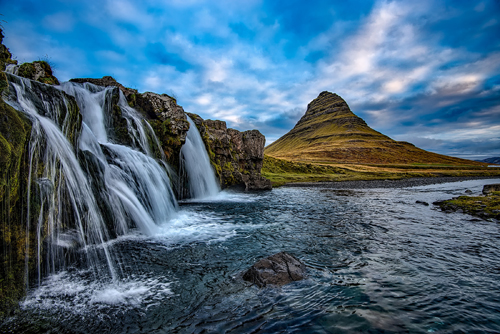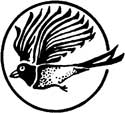To Sunday, June 10, 2018
 An other-worldly accident of volcanoes, glaciers, waterfalls, lava fields, geysers, fjords and black sand beaches, Iceland must be seen to be believed. Astride the American and European tectonic plates, this island on the edge of the Arctic Circle is still being shaped by the geologic forces that created it. And, with fewer than one-third of a million people, wildness dominates. The quality of the birdlife here cannot be understated. Perusing the mossy fields beyond the capital city of Reykjavík, common roadside birds include Snow Bunting, Common Redshank and European Golden-Plover, executing slow-motion, butterfly-like display flights. The lumbering take-off of an immense White-tailed Eagle may also freeze our progress. Along the Snæfellsnes peninsula, nesting Parasitic Jaegers and Red-throated Loons dot the tundra and coastline. Lava fields abut the glacier-filled volcano Snæfellsjökull, home to Rock Ptarmigan and Northern Wheatear. Basalt cliffs hold colonies of all five of Iceland’s breeding alcids, including Thick-billed Murre, plus large numbers of Black-legged Kittiwake. Purple Sandpipers at Grundarfjörður are downright tame, and with luck a knobby-billed King Eider can be teased out from the more numerous Common Eiders. Orcas are frequently spotted just offshore. A short boat excursion among the innumerable islets of Breiðafjörður Bay provides excellent views of Atlantic Puffin, Black Guillemot, and European Shag. Pink-footed Geese graze in the valley bottoms, and rushing rivers harbor the improbably patterned Harlequin Duck, while Eurasian Wren and Redwing fill wooded lots. We’re sure to encounter the magnificent Whooper Swan – at up to 30 pounds, one of the world’s heaviest flying birds. The picturesque town of Húsavík has emerged as a whale-watching hub: White-beaked Dolphin, Minke, Humpback, and Blue Whale are regulars. Nearby, Lake Mývatn offers a smörgåsbord of breeding avifauna. The main attraction, the powerful Gyrfalcon, can occur anywhere in the vicinity. Breeding nowhere else in Europe, Barrow’s Goldeneye shares the tundra ponds with Common Scoter, Eurasian Wigeon, Long-tailed and Tufted Ducks. Other boreal birds include Short-eared Owl, Merlin, Common Ringed Plover, Black-tailed Godwit, White Wagtail and Meadow Pipit. Naturally we won’t overlook stunning waterfalls such as Europe’s largest, the thundering Dettifoss – flowing at a rate of 500 cubic meters per second. Returning southward, we’ll take in the geothermal field at Geysir, origin of the very word “geyser.” We’ll marvel not only at this namesake feature, but also at the famous Strokkur, erupting every 10 minutes to heights of 100 feet or more. Iceland’s ubiquitous natural hot springs are just the surface expression of unimaginable subterranean energy–it is noteworthy that all of Iceland’s electricity is generated from geothermal and hydropower. With no standing army and virtually non-existent crime, Iceland is ranked as the most peaceful country in the world. Join us this summer under the midnight sun in one of the world’s most unique and welcoming destinations.
An other-worldly accident of volcanoes, glaciers, waterfalls, lava fields, geysers, fjords and black sand beaches, Iceland must be seen to be believed. Astride the American and European tectonic plates, this island on the edge of the Arctic Circle is still being shaped by the geologic forces that created it. And, with fewer than one-third of a million people, wildness dominates. The quality of the birdlife here cannot be understated. Perusing the mossy fields beyond the capital city of Reykjavík, common roadside birds include Snow Bunting, Common Redshank and European Golden-Plover, executing slow-motion, butterfly-like display flights. The lumbering take-off of an immense White-tailed Eagle may also freeze our progress. Along the Snæfellsnes peninsula, nesting Parasitic Jaegers and Red-throated Loons dot the tundra and coastline. Lava fields abut the glacier-filled volcano Snæfellsjökull, home to Rock Ptarmigan and Northern Wheatear. Basalt cliffs hold colonies of all five of Iceland’s breeding alcids, including Thick-billed Murre, plus large numbers of Black-legged Kittiwake. Purple Sandpipers at Grundarfjörður are downright tame, and with luck a knobby-billed King Eider can be teased out from the more numerous Common Eiders. Orcas are frequently spotted just offshore. A short boat excursion among the innumerable islets of Breiðafjörður Bay provides excellent views of Atlantic Puffin, Black Guillemot, and European Shag. Pink-footed Geese graze in the valley bottoms, and rushing rivers harbor the improbably patterned Harlequin Duck, while Eurasian Wren and Redwing fill wooded lots. We’re sure to encounter the magnificent Whooper Swan – at up to 30 pounds, one of the world’s heaviest flying birds. The picturesque town of Húsavík has emerged as a whale-watching hub: White-beaked Dolphin, Minke, Humpback, and Blue Whale are regulars. Nearby, Lake Mývatn offers a smörgåsbord of breeding avifauna. The main attraction, the powerful Gyrfalcon, can occur anywhere in the vicinity. Breeding nowhere else in Europe, Barrow’s Goldeneye shares the tundra ponds with Common Scoter, Eurasian Wigeon, Long-tailed and Tufted Ducks. Other boreal birds include Short-eared Owl, Merlin, Common Ringed Plover, Black-tailed Godwit, White Wagtail and Meadow Pipit. Naturally we won’t overlook stunning waterfalls such as Europe’s largest, the thundering Dettifoss – flowing at a rate of 500 cubic meters per second. Returning southward, we’ll take in the geothermal field at Geysir, origin of the very word “geyser.” We’ll marvel not only at this namesake feature, but also at the famous Strokkur, erupting every 10 minutes to heights of 100 feet or more. Iceland’s ubiquitous natural hot springs are just the surface expression of unimaginable subterranean energy–it is noteworthy that all of Iceland’s electricity is generated from geothermal and hydropower. With no standing army and virtually non-existent crime, Iceland is ranked as the most peaceful country in the world. Join us this summer under the midnight sun in one of the world’s most unique and welcoming destinations.
Leader: John Yerger
Cost of Iceland includes all accommodations, all meals, all ground transportation, and all entrance fees beginning and ending in Reykjavik—$5,495.
TO REGISTER: Print out a PDF Registration Form, call us at (520) 558-2351 or This email address is being protected from spambots. You need JavaScript enabled to view it..
Photo: Kirkjufell and waterfall, Iceland
Photo by: David Mark







